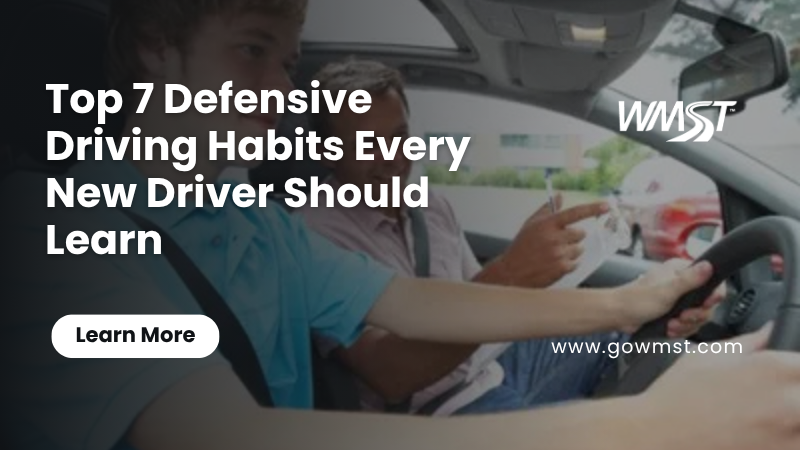What Is Defensive Driving? And Why It Matters
Defensive driving refers to the ability to anticipate hazards, react safely, and make proactive decisions that reduce the risk of collisions. While not a separate “class” at WMST, defensive driving habits are taught and reinforced through behind-the-wheel training and classroom education.
For new drivers, especially in Washington State, mastering these habits is crucial. It’s not enough to know the rules of the road, you must also understand how to stay alert, respond to unpredictable situations, and protect yourself and others.
These skills not only contribute to safety but also improve your confidence and control behind the wheel.
1. Maintain a Safe Following Distance (The 4-Second Rule)
Keeping the right distance between your car and the one in front is essential. The 4-second rule helps drivers create enough space to react if the car ahead brakes suddenly, regardless of the speed of traffic.
How it works:
- Pick a stationary landmark (like a road sign).
- When the vehicle ahead passes it, start counting: “One-one-thousand… two-one-thousand…” up to four.
- If you reach the landmark before four seconds, you’re too close.
- The 4-second rule is the minimum for new driver under ideal conditions. When the conditions are less than ideal, the 4-second rule should be expanded to five or six seconds.
In Washington, this rule is particularly important to give new drivers adequate time to process, plan and react to any given hazard. WMST reinforces this principle during in-car sessions as a critical WA driving skill.
2. Minimize Distractions While Driving
Distracted driving is one of the leading causes of accidents nationwide. Defensive drivers prioritize attention over convenience.
Tips to reduce distractions:
- Put your phone away or use “Do Not Disturb” mode.
- Avoid eating or drinking while driving.
- Set your navigation and playlist before you begin driving.
- Limit conversations, especially in the early stages of learning.
At WMST, students are taught to recognize distractions and develop habits that keep their eyes, hands, and minds focused on driving.
3. Stay Alert and Scan the Road Ahead
Being alert means constantly analyzing what’s happening in front, beside, and behind your vehicle. Scanning the road 12–15 seconds ahead gives you time to spot potential hazards like:
- Sudden stops
- Pedestrians
- Bicyclists
- Vehicles merging or braking
Students are encouraged to move their eyes regularly, checking mirrors every 5–8 seconds, especially in high-traffic areas or intersections.
This habit helps new drivers stay proactive instead of reactive.
4. Communicate Clearly with Other Drivers
Communication is more than using your horn. It’s about signaling your intentions clearly so other drivers can anticipate your next move.
Best communication habits include:
- Using turn signals every time you change lanes or turn
- Flashing brake lights early to indicate a stop
- Using headlights in low visibility
- Making eye contact with pedestrians or other drivers at intersections
- Positioning your vehicle in the lane to see and be seen, which will also communicate your intentions
Teaching these habits helps students better understand driving safety education from both a legal and practical standpoint.
5. Adjust Speed to Conditions
Speed limits aren’t always safe, especially in poor weather or heavy traffic. A defensive driver adjusts their speed based on:
- Road surface (wet, icy, gravel)
- Visibility (fog, night driving)
- Traffic congestion
- Construction zones
- Mental state
In Washington, where the weather can shift quickly, this habit is essential. WMST instructors guide students through real-time speed adjustment scenarios, including braking distance and speed-to-visibility correlation.
6. Stay Calm and In Control
Emotional control is just as important as physical driving skills. Road rage, frustration, or panic can lead to unsafe behavior.
Defensive drivers stay composed by:
- Avoiding confrontations with aggressive drivers
- Managing stress before getting behind the wheel
- Practicing calming breathing techniques during lessons
Staying calm improves decision-making and reaction time, two critical elements assessed during the Skills Test.
7. Prepare for the Unexpected
Lastly, a good defensive driver always has a “what if” mindset:
- What if that parked car suddenly pulls out?
- What if that green light turns yellow?
- What if a child runs into the street?
Developing these situational questions in your thought process improves overall awareness and supports accident prevention tips that could save lives.
Frequently Asked Questions (FAQs)
Is defensive driving a separate class at WMST?
No. WMST does not offer a specific “defensive driving class,” but defensive habits are built into the core of both classroom and behind-the-wheel instruction.
Why are defensive habits important for new drivers?
They help new drivers anticipate problems before they happen, reducing the risk of collisions and building long-term safe driving behavior.
Does the Skills Test assess these habits?
Yes. While the test checks for specific maneuvers, safe habits like maintaining distance, signaling properly, and managing speed are also observed by examiners.
Can these habits help prevent accidents?
Absolutely. Most road accidents are avoidable. Defensive driving habits greatly reduce your risk of crashes caused by distraction, speeding, or misjudgment.
Does WMST teach these through behind-the-wheel sessions?
Yes. Instructors emphasize these habits during all sessions and help students apply them in real-world scenarios, including city, highway, and residential driving.
Conclusion: Practice Defensive Driving from Day One
New drivers face a steep learning curve, but incorporating these defensive driving habits early builds a solid foundation for long-term safety.
At WMST, students receive comprehensive, practical training that integrates these essential habits through guided lessons and real-world driving experience. These aren’t just good habits, they’re life-saving practices every new driver in Washington should master.For more information on enrolling in behind-the-wheel instruction or preparing for the Skills Test, visit WMST’s official website and take the first step toward safer, smarter driving.

